The kinematic structure of the key element indices of sports technique connecting move of acrobatic exercises round-off – salto backward tucked performed on a beam
ˑ:
Dr.Hab., Professor Tomasz Niznikowski1
Dr.Hab., Professor J. Sadowski2
1Jozef Pilsudski Academy of Physical Education in Warsaw, Poland
2Department of Physical Education and Sport in Biala Podlaska, Poland
Кeywords: female athletes, beam, round-off, salto backward, kinematic structure, sports technique, exercise phases, key elements.
Introduction. Balance beam exercises represent the event of woman’s all-around gymnastics that symbolizes the priority of accuracy, grace of movements of female gymnasts, perfect regulation of body posture. Modern exercises on a beam are, in fact, floor exercises transferred to a narrow support, including very complex acrobatic jumps. According to experts in artistic gymnastics events, composition performed on a beam, the structure of which contains acrobatic exercises, should be executed in accordance with the difficulty of the program and the specific requirements of the competition [1,2,3,4,5,6,8,12].
Analysis of gymnasts’ performances in the competitions indicates that most of technical faults in the process of executing salto elements on a beam are committed during pushing off and landing. We have revealed a positive role of the method of motion postural landmarks in the process of analyzing techniques and mastering sports exercises, which permits to analyze and evaluate the key elements of sports technique.
The key element represents a signal point (posture) of motion predetermining optimum motor actions in phase structure of the exercise. It has been established that body postures and positions in the structure of competitive exercises predetermine the biomechanics of previous and subsequent motions: the previous element (posture) contains the properties (speed-strength, spatial-temporal, tempo-rhythmical, etc.) of the subsequent one. In case of their optimum ratio, the athlete performs the exercise or the connecting part of exercises with slight motor rearrangements without accumulating technical faults [1,3,5,6, 8,10, 11, 12].
Taking into account the multifunctional purpose of acrobatic exercises performed on a beam (performing to stop, on transition, in a connection of exercises), the role of technically correctly assumed body positions fixed for optimum time on the support for effective pushing off, rotation and stable landing, increases. Successful solution of the tasks of biomechanical analysis of gymnastic, acrobatic exercises and the development of modern training programs will enable to put into operation significant effective reserves of educational and training process and competitive activities [2,4, 5,7, 8,12,13,14].
Objective. To study the kinematic structure of the key element indices of sports technique connecting move of acrobatic exercises round-off – salto backward tucked performed on a beam; to single out sports technique key elements in the phase structure of exercises.
Tasks. 1. To make biomechanical measurements of connecting move of acrobatic exercises round-off – salto backward tucked performed on a beam.
2. To study the kinematic structure of the key element indices of sports technique connecting move of acrobatic exercises round-off – salto backward tucked performed on a beam.
Research mеthods. 1. Video recording the connecting move of acrobatic exercises round-off – salto backward tucked performed on a beam by two digital cameras JVS 6R-DVL 9800 NTSC with shooting speed of 240 frames per second. Measurement error constituted 3% [1,3,8,12]. The study involved skilled and highly skilled female gymnasts (п=16). Their average indices of height, body mass and age (х±δ) constituted 157,5±2,85 cm; 51±2,25 kg; 20±2,35 years, respectively.
2. APAS 2000 (Ariel Dynamice Inc.) computer program was used for analysis of motion joint angles of an athlete during execution of round-off – salto backward tucked on a beam with the task of stable landing; velocities and accelerations of ankle, knee, hip, shoulder, elbow and wrist joints and body GCM; as well as body postures and positions on support and in support-free environment; time of exercise phase execution; method of motion postural landmarks; during salto execution the motions of the extremities are symmetrical.
Results of study. Sports technique key elements in phase structure of exercise connecting move. As a result of biomechanical analysis of connecting move of acrobatic exercises round-off – salto backward tucked executed on a beam, the motion phase structure has been established and examined. The final phase of round-off had to be analyzed (through active actions of flick down – assumption of body vertical position that forms the phase of preparatory motor actions for flying up on salto). The phase of the main motor actions (salto part) and that of final ones (landing) were highlighted. The phase structure of motions in studied connecting move of exercises was considered as a structural-functional integrity, cause-and-effect causation.
Figure 1 shows the kinematic structure and the trajectory of the body general centre of mass (GCM) displacement during performance of round-off – salto backward tucked on a beam (stable landing). Biomechanical analysis of the acrobatic exercise connecting move has allowed to outline in the structure of round-off the key element of sports technique – the body launching posture (LP), i.e., biomechanically stable vertical position of gymnast body during concluding the round-off in the coordinate system on the support, which provides efficient conditions for pushing off and directed upward-backward flying up to enter the main (salto) phase of motor actions, whereas in the phase of the main motor actions – the key element of multiplication of body posture (MP) “salto tuck position”. Multiplication of body posture of “tuck position” is a process of successive alternating of body tucked position for creating the dynamic and integral salto backward tucked that determines and characterizes the exercise content; in the final phase – the key element of sports technique of body concluding posture (CP) – landing, which is coherent with the studies on technical preparation and technical fitness in gymnastics events [1,2, 3, 4, 5, 6, 8,10,11].
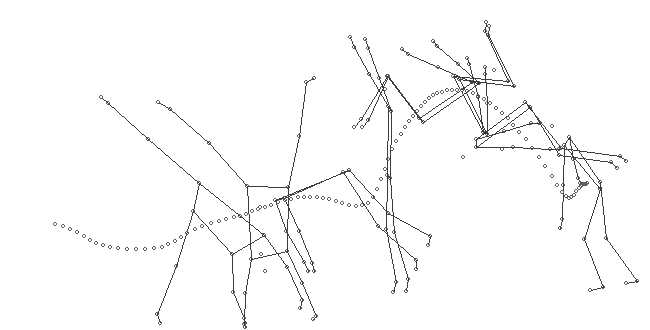
Fig. 1. Kinematic structure and trajectory of the body general centre of mass (GCM) displacement during performance of the connecting move of acrobatic exercises round-off – salto backward tucked on a beam.
Phase of preparatory motor actions. Biomechanical analysis of the indices that characterize the LP as the key element of the final motor actions of round-off preceding salto backward tucked performed on a beam (time 0,08 sec).
The LP of the body in front of vertical (thigh-trunk angle is equal to 171,67°) was recorded on support with arms fore-upward, on toes in narrow stand with legs apart, according to scheme one leg in front of the other (Fig.2).
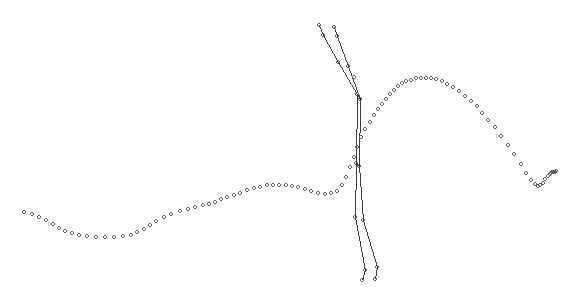
Fig. 2. Phase of preparatory motor actions – key element of sports technique – launching body posture in the phase of concluding motor actions of round-off of the connecting part of exercises round-off – salto backward tucked performed on a beam (time 0,08 sec).
During execution of the connecting move of acrobatic exercises round-off – salto backward tucked on a beam (time 0,08 sec) {Fig.3}, the flying up on salto is preceded by the final phase of round-off (flick down feet placement on support), which is characterized by high velocities of motions of body biolinks: the velocity of ankle joint motion within 0,08 sec constituted 3,09 m/s, that of knee joint – 3,00 m/s, that of hip joint – 2,99 m/s, that of shoulder joint – 3,75 m/s, that of elbow – 5,99 m/s, and that of wrist joint – 8,49 m/s. The above resulted in insufficient coordination of the velocity curves (resultant) of body biolinks during short-term fixation of LP on the support before pushing off due to feet placement on the support with increasing velocity of motions in the flick down part of the round-off, thus leading to some “dispersion of curves” of body biolinks velocities. As far as the performers were highly skilled female gymnasts, we attribute the revealed peculiarities of executing the body launching postures to the individual style of sports technique as well as consider as an opportunity to further improve the motor skill of performing this extremely significant key element of sports technique – the body launching posture.
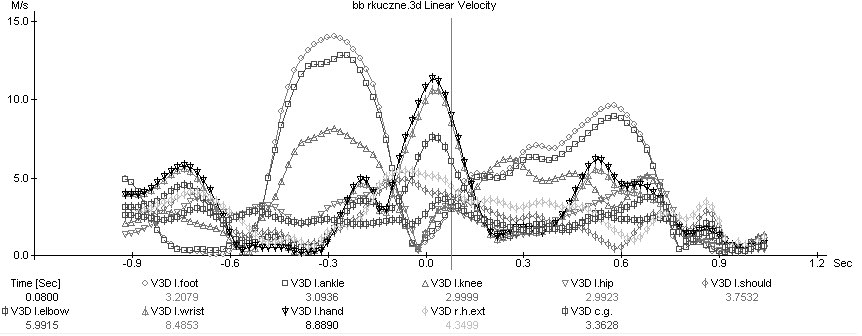
Fig. 3. Trajectories of resultant velocities of displacing ankle, knee, hip, shoulder, elbow and wrist joints as well as athlete body GCM at the moment of short-term fixation of the body launching posture in the final phase of round-off (phase of preparatory motor actions) during performance of the connecting move of exercises: round-off – salto backward tucked on a beam.
Note: GCM – general centre of mass.
The resultant velocities of vertical and horizontal constituents of the body biolinks and GCM (Fig. 3) during performance of the connecting move of exercises round-off – salto backward tucked on a beam while assuming the launching posture are differentiated. The reason of these differentiated velocities (especially the velocity of shoulder and wrist joints constituting 3,75 m/s and 8,49 m/s, respectively) are the individual peculiarities of sports technique of executed within round-off flick down, which precedes salto backward tucked.
Phase of the main motor actions. Key element of sports technique – multiplication of body posture (MP) “tucked” during performance of salto backward tucked (time 0,28 sec). The gymnast is in the process of tucking - the thigh-trunk angle is equal to 101,03° (Fig. 4).
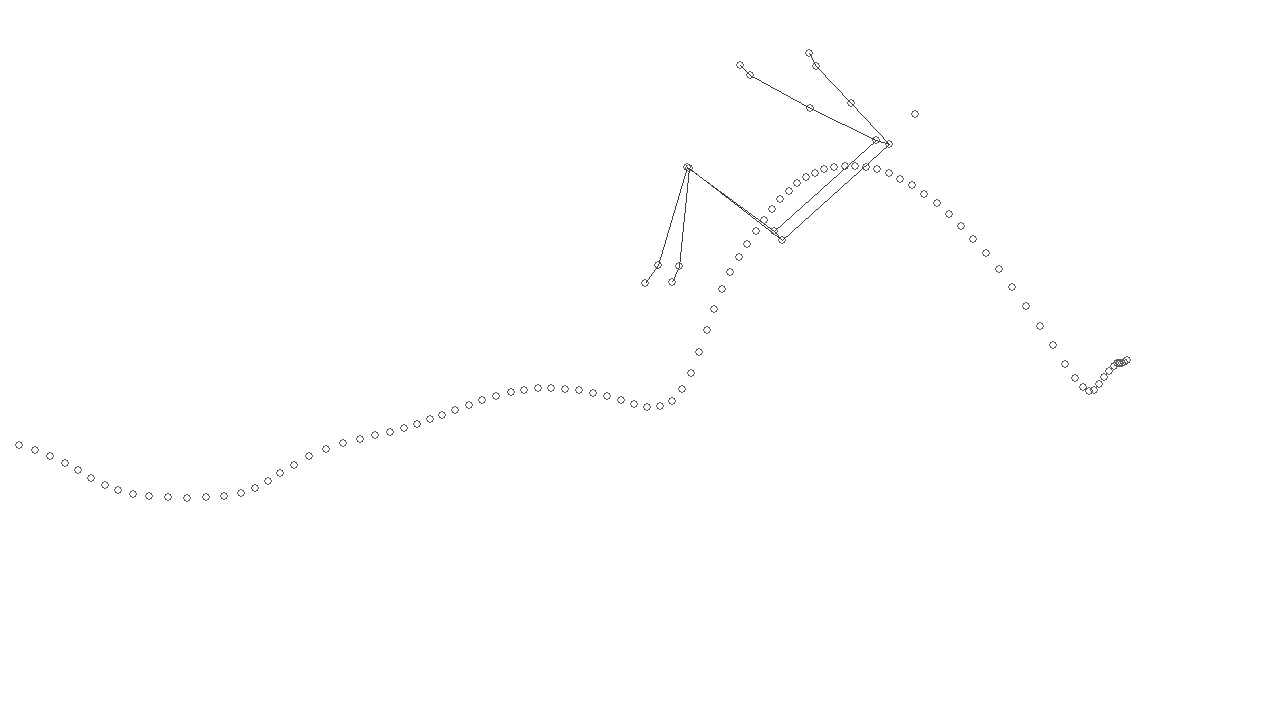
Fig. 4. Phase of the main motor actions. Key element of sports technique – multiplication of “tucked” body posture – in the connecting part of acrobatic exercises round-off – salto backward tucked performed on a beam (time 0,28 sec).
Figure 5 displays the trajectories of resultant velocities of displacing ankle, knee, hip, shoulder, elbow and wrist joints as well as athlete body GCM in the phase of the main motor actions – tucked body posture multiplication during salto performance in the connecting part of round-off – salto backward tucked on a beam (time 0,28 sec). They reveal the cause-and-effect dependencies of energy transfer from the previous motions (postures) to the subsequent ones. For instance, the increased velocities of the ankle and knee joint motions are recorded on the ascending part of the flight trajectory, which activates the motor actions - rotations around the transverse axis.
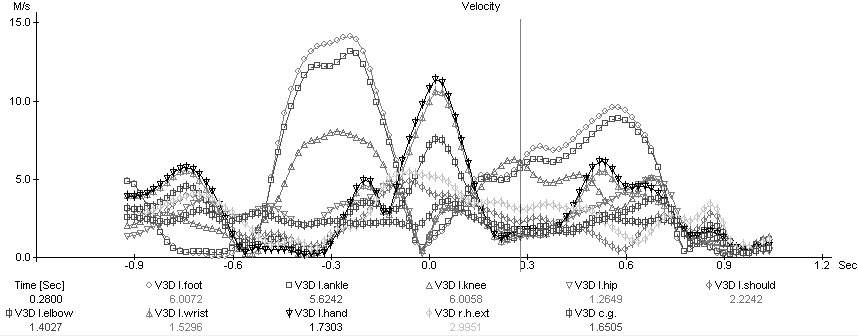
Fig. 5. Trajectories of resultant velocities of displacing ankle, knee, hip, shoulder, elbow and wrist joints as well as athlete body GCM in the phase of the main motor actions – MP of body during performance of the connecting move of exercises round-off – salto backward tucked on a beam (time 0,28 sec).
Velocity of motion in ankle joints increased by 5,62 m/s from 0,08 sec to 0,28 sec, whereas in knee, hip and shoulder joints – by 6,01 m/s, 1,26 m/s and 2,22 m/s, respectively. It decreased in elbow and wrist joints by 1,40 m/s and 1,53 m/s, respectively. Velocity of body GCM displacement constituted 1,65 m/s.
In the further part of the connecting move of body MP (Fig.6) the athlete performs 1/2 salto on the ascending segment of flight trajectory within round-off – salto structure (time 0,44 sec), thigh-trunk angle is equal to 62,19°.
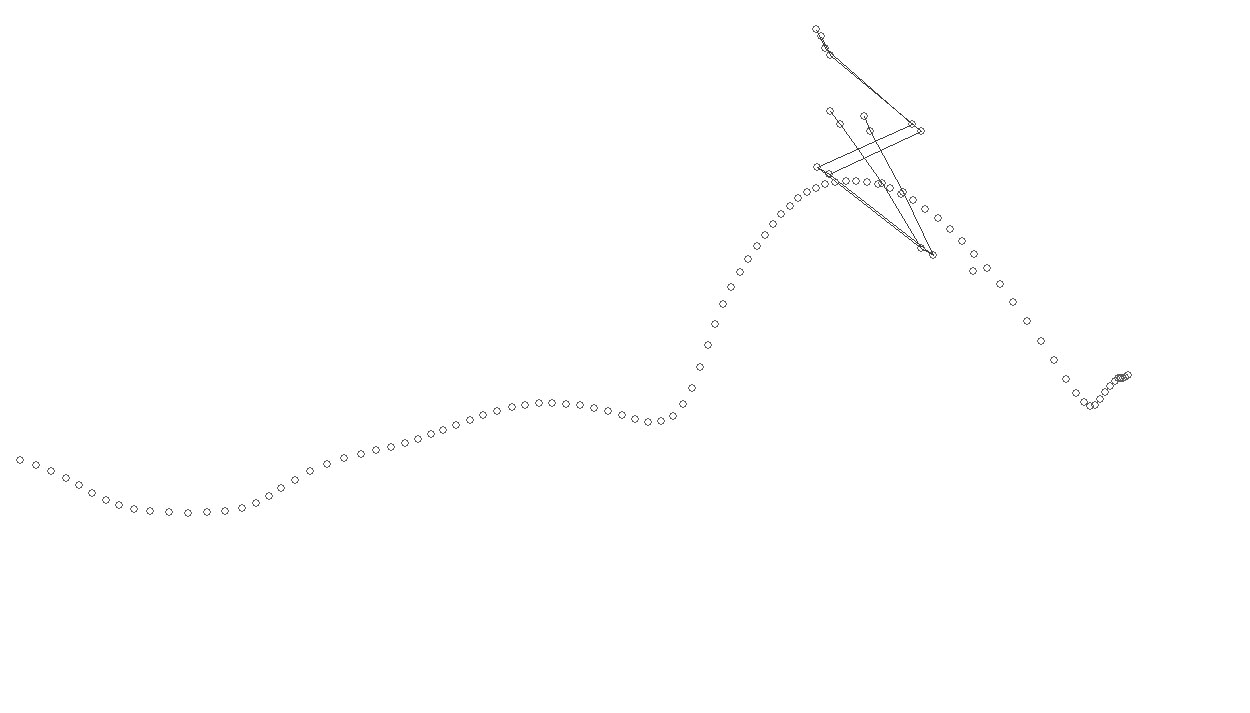
Fig. 6. Phase of the main motor actions. Key element of sports technique – tucked body MP - in the connecting part of exercises round-off – salto backward tucked executed on a beam (time 0,44 sec).
During performance of ½ salto the gymnast is tightly tucked (Fig.6), the velocity of ankle and knee joints is increased, which will enable preparation for execution of the phase of concluding motor actions – preparation for landing. This is also evidenced by the trajectories of resulting velocities that characterize the displacement of the ankle, knee, hip, shoulder, elbow, and wrist joints, as well as the athlete's GCM in the phase of the main motor actions - body MP during performance of the connecting move of exercises round-off - salto backward tucked on a beam (time 0.44 s) (Fig.7).
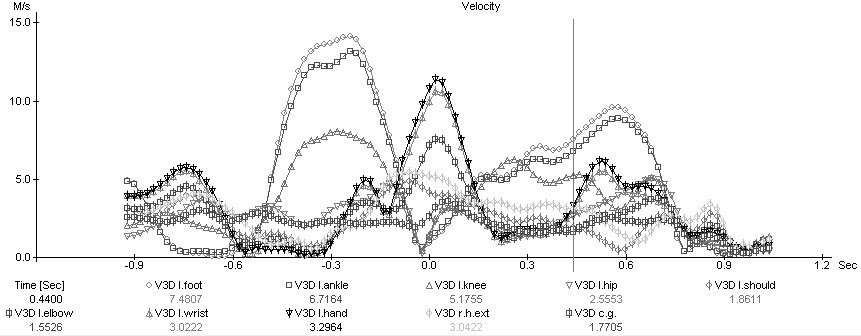
Fig. 7. Trajectories of resultant velocities of displacing ankle, knee, hip, shoulder, elbow and wrist joints as well as athlete body GCM in the phase of the main motor actions – MP of body during performance of the connecting move of exercises round-off – salto backward tucked on a beam (time 0,44 sec).
As illustrated in Fig. 7, the velocity of ankle joint movement at the moment 0,44 is equal to 6,72 m/sec, that of knee joint – 5,18 m/sec, that of hip joint – 2,56 m/s, that of shoulder joint – 1,86 m/sec, that of elbow joint – 1,55 m/sec and that of wrist joint – 3,02 m/sec. The velocity of body GCM (time 0,44 sec) constitutes 1,77 m/sec.
Phase of the final motor actions. The gymnast (time 0,62 sec) exercises motor preparation for landing execution – the key element of sports technique of body concluding posture – CP. This preparation for landing is characterized by descending flight trajectory, joint angles (thigh-trunk angle equal to 91,22°) (Fig.8) as well as presented in Fig.9 trajectories of resultant velocities of displacing ankle, knee, hip, shoulder, elbow and wrist joints as well as athlete body GCM in the phase of the final motor actions during performance of the connecting move of exercises round-off – salto backward tucked on a beam (time 0,62 sec).
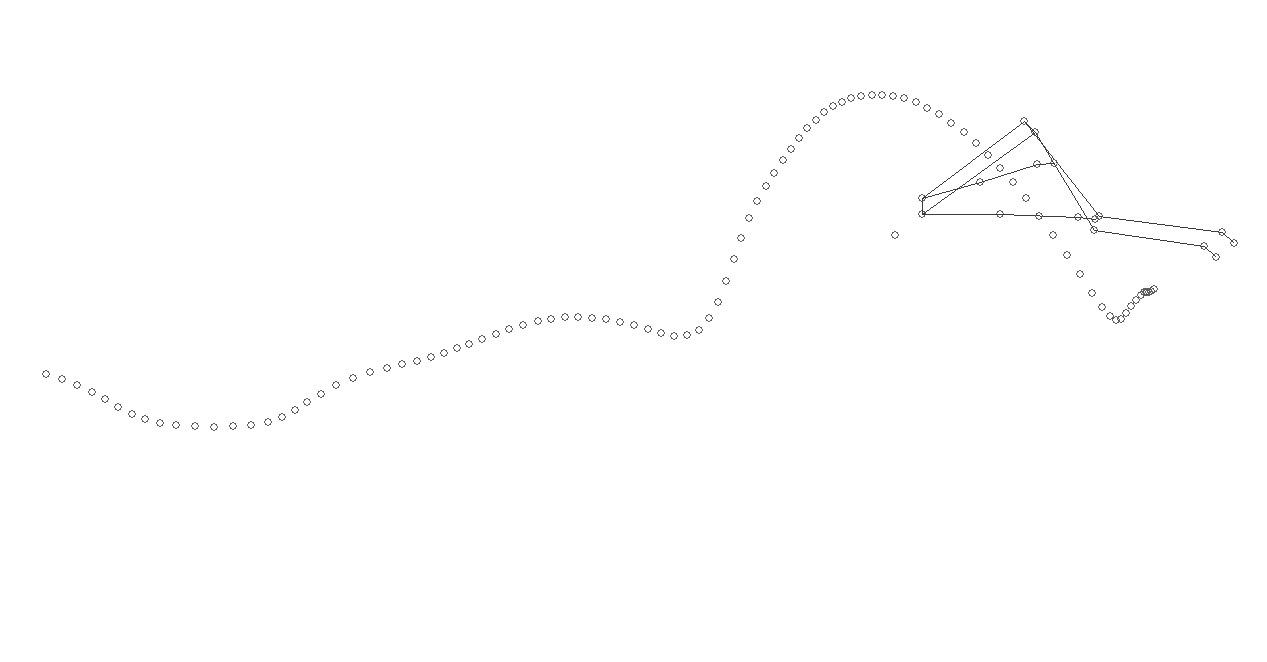
Fig. 8 Phase of the final motor actions during performance of the connecting move of acrobatic exercises round-off – salto backward tucked on a beam (time 0,62 sec).
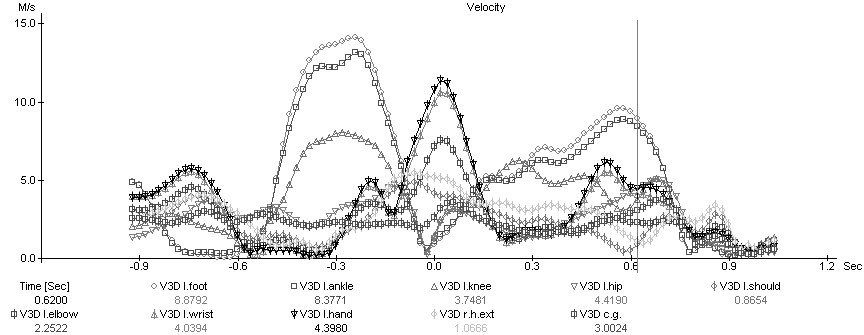
Fig. 9. Trajectories of resultant velocities of displacing ankle, knee, hip, shoulder, elbow and wrist joints as well as athlete body GCM in the phase of the final motor actions – body (CP) during performance of the connecting move of exercises round-off – salto backward tucked on a beam.
Velocity of motion of the ankle (time 0,62 m/sec), knee, hip, shoulder, elbow and wrist joints constitutes 8,38 m/sec, 3,75 m/sec, 4,42 m/sec, 0,87 m/sec, 2,25 m/sec and 4,04 m/sec, respectively. Velocity of body GCM is equal to 3,00 m/sec (Fig.9).
Figure 10 shows body CP in the phase of the final motor actions – stable landing on a beam (time 1,04 sec). Thigh-trunk angle is equal to 153,31°. Biomechanical analysis and pedagogical observations allow to conclude that the athlete demonstrates an elastically rigid interaction with the support that contributed to assuming CP – semi-tuck stride position with one leg in front of the other and body semi-bent forward, arms forward-downward.
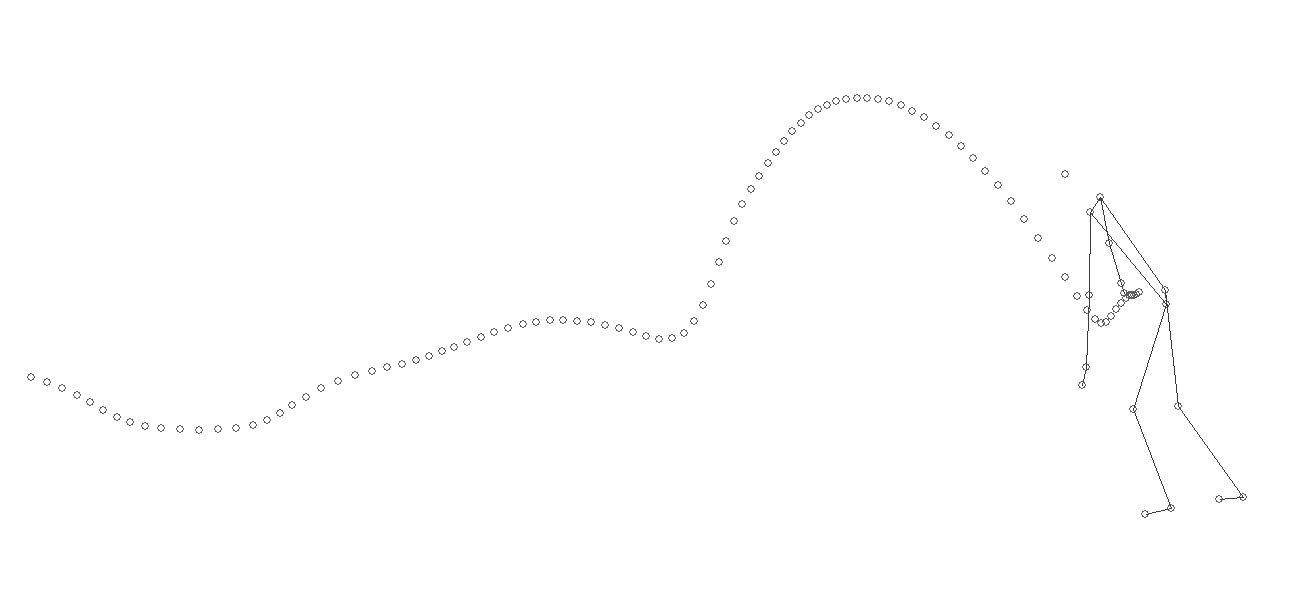
Fig. 10. Phase of the final motor actions (CP) – landing after performance of the connecting move of acrobatic exercises round-off – salto backward tucked on a beam (time 1,04 sec).
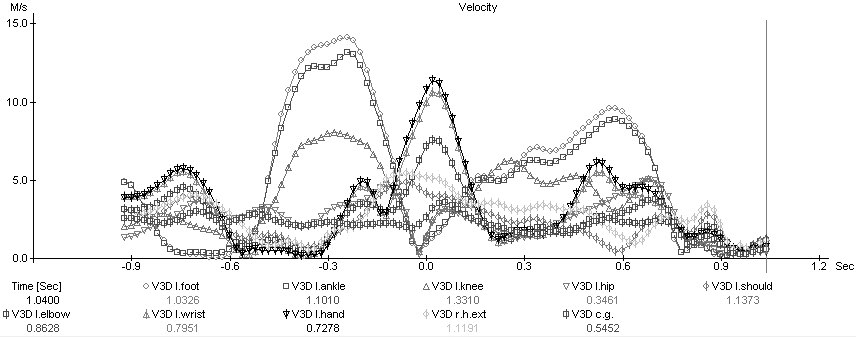
Fig. 11. Trajectories of resultant velocities of displacing ankle, knee, hip, shoulder, elbow and wrist joints as well as athlete body GCM in the phase of the final motor actions – body (CP) during performance of round-off – salto backward tucked on a beam (time 1,04 sec).
Figure 11 shows the trajectories of resultant velocities of body biolinks displacements during performance of the connecting move of acrobatic exercises round-off – salto backward tucked on a beam. Velocity of the ankle (at the time of 1,04 sec), knee, hip, shoulder, elbow and wrist joints is equal to 1,33 m/sec, 0,35 m/sec, 1,14 m/sec, 0,86 m/sec and 0,8 m/sec, respectively. Body GCM is displaced with the velocity of 5,81 m/sec. Body posture on the support is characterized by the key element of sports technique – CP, i.e., posture of landing (semi-tuck position with body semi-bent forward – on the support – stride position with one leg in front of the other, arms forward-downward). The resultant velocities of body biolinks and GCM are the confirmation of the controlled motor actions during stable landing. They “have gathered” in a “bunch” (time 1,04 sec).
Conclusion. Analysis of scientific and methodical literature, practical experience indicate the importance of studying and teaching the technique of gymnastic, acrobatic exercises with account for the knowledge about the posture and position of athlete body. In this regard, V.N.Boloban and E.V.Biryuk suggested using the method of postural landmarks and their key elements for studying the technique of exercises of artistic gymnastics events [1]. It represents the method of biomechanical study of sports exercises by means of analysis of previous and subsequent body postures and positions and their multiplications in the phase structure of executed exercise in order to perceive the key elements of sports technique. The results of conducted study allow to assume that the conceptual essence of the method of motion postural landmarks is that each previous body posture in performed sports exercise should positively impact the biomechanics of subsequent one, carry the properties enabling exercise performance without unnecessary motor rearrangements, so that to avoid the accumulation of technical faults in the process of exercise demonstration. The key elements of sports technique play a positive role in the process of learning the exercises, because they provide the basis for building the didactic construction for the formation of skills and abilities of motor actions in the phase structure of sports exercise [3,5,6,8,10,12]. In this respect, the method of motion postural landmarks underlies practical methodology of biomechanical and didactic improvement of technical preparation and technical fitness in sports events with complex coordinated structure of motions by means of implementing the indices of sports technique key elements in the phase structure of exercises (connecting move of exercises, transition from one motor action to the subsequent one within the exercise, transition to the next element in composition, firm stand – stable landing on support).
Biomechanical studies and educational experiments have confirmed the expediency of using the method of motion postural landmarks as an efficient means for analysis and assessment of sports technique elements as well as for the development of didactic technologies of training sports exercises of different coordination complexity [1,5,8,10]. In addition to the results obtained in gymnastics sports events, positive results were also achieved in track and field. For instance, the studies {9} recommend to use the postural method for training the technique of track and field running. The authors distinguish three postures: posture of running, attacking and landing after hurdle clearing; in high jumps – those of running, exiting and over the bar; in long jumps – those of running (during run-up and “scissor” flight), exiting in a stride (during taking-off) and landing. The authors accentuate that the subject of training should be the body posture and the reproduction of postures.
Conclusions. 1. The key elements of sports technique have been revealed by the method of motion postural landmarks in phase structure of the connecting move of acrobatic exercises round-off – salto backward tucked performed on a beam. It has been established that the key element of sports technique is the motion signal point (posture) determining the efficient current and subsequent motor actions in phase structure of exercise connecting move. It has been proved that the signal points (postures) in examined connecting moves of exercises are: launching posture (LP) of the body (biomechanically rational body posture on the support for efficient flying up on salto), multiplication of postures (MP) of the body (successive alternating instant, fixed postures for creation of an integral motor action), concluding posture (CP) of the body (landing to stop).
2. Biomechanical structure of the key elements of sports technique of the connecting moves of exercises round-off – salto backward tucked performed on a beam is characterized by individual biomechanical indices of executing the launching body posture, multiplication of body postures and concluding body posture: joint angles of athletes’ motions, the velocities of ankle, knee, hip, shoulder, elbow, wrist joints and body GCM; body postures, body positions on the support and in support-free environment; time of exercise phase performance.
3. Indices of sports technique key elements in the phase structure of exercises undergo the development and improvement on the basis of using exemplary training programs for the benefit of enhancement of the motion control quality, with account for the individual level of sports fitness, specifics and difficulty of sports exercises.
References
- Boloban V.N. Regulyatsiya pozy tela sportsmena [Regulation of athlete body posture]. Kiev: NUPESU: Olimp. lit. publ., 2013. 232 p
- Gaverdovsky Yu.K. Teoriya i metodika sportivnoy gimnastiki [Тhеоry and methods of artistic gymnastics]. Textbok v 2 v. v. 1. Moscow: Sovetskiy sport publ, 2014. pp. 305-323.
- Potop V.A., Grad R., Boloban V.N., Otsupok A.P. Biomekhanicheskaya kharakteristika soskokov s gimnasticheskogo brevna na osnove analiza uzlovykh elementov sportivnoy tekhniki [Biomechanical characteristics of beam dismounts based on analysis of sports technique key elements]. Pedagogika, psikhologiya i mediko-biologicheskie problemy fizicheskogo vospitaniya i sporta [Pedagogics, psychology and medico-biological problems of physical education and sport], 2013. no. 12. pp. 58-66.
- Sadowski J. , Boloban V., Niźnikowski T., et al. Poznye orientiry dvizheniy kak metod analiza i otsenki pokazateley kinematicheskoy strukturyi uzlovykh elementov sportivnoy tekhniki bazovoy svyazki uprazhneniy «perevorot vpered – salto vpered v gruppirovke» [Motion postural landmarks as the method of analysis and assessment of the indices of kinematic structure of key elements of sports technique of basic connecting move of exercises «turn over forward – salto forward tucked»]. Teoriya i praktika fiz. kultury. 2012. no. 7. pp. 98-102.
Acknowledgements: The research was financed from grant N RSA4 03254 within the "Development of Sports at University” project
Corresponding author: fizkult@teoriya.ru
Аbstract. Objective. To study the kinematic structure of the key element indices of sports technique connecting move of acrobatic exercises round-off – salto backward tucked performed on a beam; to single out sports technique key elements in the phase structure of exercise connecting move. Material and methods. The study involved skilled and highly skilled female gymnasts (n = 16). Their average indices of height, body mass and age (x ± δ) constituted 157.5 ± 2.85 cm; 51 ± 2.25 kg; 20 ± 2.35 years, respectively. Performance of the connecting move of acrobatic exercises round-off – salto backward tucked on a beam was recorded by two digital video cameras JVS 6R-DVL 9800 NTSC with shooting speed of 240 frames per second. Measurement error constituted 3%. APAS 2000 (Ariel Dynamice Inc.) computer program was used for analysis of motion joint angles, velocities, accelerations of joints and body GCM; time of exercise phase execution; method of motion postural landmarks. Results. Sports technique key elements in the phases of the connecting move of acrobatic exercises round-off – salto backward tucked performed on a beam were determined along with their indices: body launching posture (LP) during the round-off finishing – close to vertical stable body posture with narrow stand and legs apart, on tiptoe on support, with arms fore-upward, for efficient upward-backward flying up; phase of the main motor actions – multiplication of body postures (MP) “tucked” – active successive alternating instant fixed salto phases for creation of an integral motor action; during the phase of the final motor actions – concluding body posture (CP) – landing to stop. Conclusions. Sports technique key elements as the signal postures of motor actions combine the indices of phase structure of the connecting move of acrobatic exercises round-off – salto backward tucked, executed on a beam, through the interaction of previous and subsequent body postures and their multiplications. They are amenable to development and improvement. Performance of exercises without unnecessary motor rearrangements is achieved, thus avoiding the accumulation of technical faults in the process of demonstrating competitive exercises.


